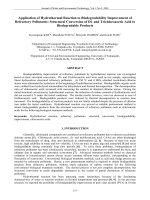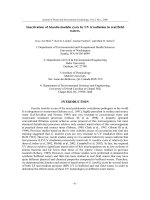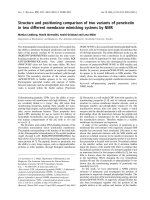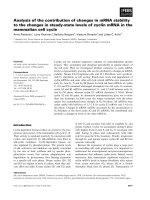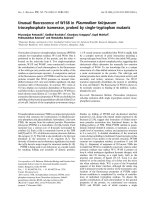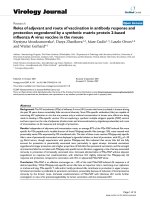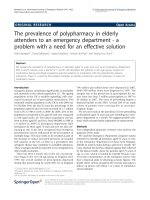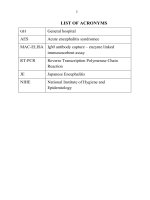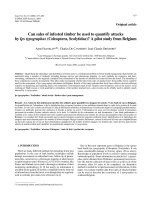Conversion of ergosterol in edible mushrooms to vitamin d2 by UV irradiation
Bạn đang xem bản rút gọn của tài liệu. Xem và tải ngay bản đầy đủ của tài liệu tại đây (1.89 MB, 156 trang )
CONVERSION OF ERGOSTEROL IN EDIBLE MUSHROOMS TO
VITAMIN D
2
BY UV IRRADIATION
JASINGHE VIRAJ JANAKAKUMARA
(B. Sc., M. Sc.)
A THESIS SUBMITTED
FOR THE DEGREE OF DOCTOR OF PHILOSOPHY
FOOD SCIENCE AND TECHNOLOGY PROGRAMME
DEPARTMENT OF CHEMISTRY
NATIONAL UNIVERSITY OF SINGAPORE
2005
ACKNOWLEDGEMENTS
I am really really thankful and grateful to my supervisor Professor Conrad O Perera for
welcoming me to the Food Science & Technology family, giving me excellent guidance,
encouragement, and his patience during the project. His enthusiastic attitude, knowledge,
and commitment for the advancement of science in the field of food science, drove me to
explore innovative knowledge in this field. Without his intellectual coherence, this
project would not have been completed.
I wish to express my heartfelt gratitude to my co-supervisor Professor Philip J Barlow for
his support, advice, and suggestions given me during the project. I really appreciate his
inspiring discussions and critical reviews made, in writing of this thesis.
I thank Prof Zhou Weibiao and Dr Lai Peng Leong, for their encouragement and support
given me during this project. I wish to thank Dr. Shyam S Sablani for his generous advice
given in kinetics and statistical analyses.
My sincere gratitude goes to Ms. Frances Lim and Ms. Lee Chooi Lan, for their skilful,
excellent technical assistance given to me during the laboratory experiments. I also wish
to thank all the non-academic staff members attached to the FST and Department of
Chemistry for their support during my stay in NUS.
I
I had the opportunity to work for a couple of months with Dr. Enoka Bandularatne, Dr.
Retnam Lesley, and the supporting staff of the Animal Holding Unit (AHU). I express
my sincere gratitude specially to Enoka who helped me a lot during my stay in AHU, and
without her kind assistance this project would not have been completed. I am grateful to
all the supporting staff at the AHU for taking care of my study animals during the study,
for providing me a splendid working environment and support towards my project.
I wish to express my thanks to Ms. Low Siew Leng, Ms. Lee Kian, and the staff of
orthopedic and referral laboratory, National University Hospital (NUH) for their
generous support in clinical analysis of samples.
I wish to thank my colleagues specially, Amar, Vel, Abul, and Guanghou for their
support and friendship given to make the lab a second home to me in Singapore.
I owe my heartfelt gratitude to my father (Abraham) and mother (Leelawathie) for
rousing my scientific curiosity during childhood, and their endless support and
encouragement given to me throughout my life. I am indebted to them for life and will
never be able to compensate. I also wish to express my warmest gratitude to my brothers
(Jayantha, Sudath, and Udesh), sister (Shyamalee), and their families for the
encouragement and continuous support given to me during my stay away from my
motherland, Sri Lanka.
II
I am grateful to the National University of Singapore for giving me this opportunity to do
my postgraduate research here in Singapore, providing me with a research scholarship
and a research grant to complete my project. I also would like to take this opportunity to
thank the office of alumni relations for providing me a travel grant to attend the World
Congress of Clinical Nutrition (WCCN2004), held in Thailand. The travel grant provided
by ASEAN to attend the regional workshop on drying technology 2003 in Indonesia is
also highly appreciated. I am also thankful to International Relations Office (IRO) for
providing me a travel grant to attend the doctoral students conference 2004, organized by
Asia Pacific Rim Universities (APRU), held at the University of Sydney, Australia.
Finally, I am greatly indebted to my nearest and dearest, for everlasting love and
affection, my wife Kumari and loving son Rashmi. You are amazing for coping with my
temper and frustration when research became nightmarish at times. I have been selfishly
absorbed countless times from my family life for this project. I express my heartfelt
sorrow for being such a husband to Kumari and specially such a father to my dearest ever
loving Rashmi. You are the ones who matter to me the most and your inducing
inspiration beyond all measures. Without your unconditional support, patience, and
wonderful sacrifices, this wouldn’t be possible at all. I am always amazed at how
wonderful you are!
III
DEDICATION
This thesis is dedicated to the rats who sacrificed their lives for the advancement of
science……………
I can assure the readers that all the rats involved in this study were
treated in a humane
fashion in accordance with the guidelines of the National University of Singapore,
painlessly killed under anesthesia, and disposed of in a manner prescribed by the
National University of Singapore.
IV
TABLE OF CONTENTS
PART I 1
INTRODUCTION AND EXPERIMENTAL 1
CHAPTER 1 2
INTRODUCTION 2
1.1: Vitamin D 3
1.1.1: Recommended daily dietary allowances (RDA) 5
1.2: Vitamin D metabolism 7
1.3: Clinical importance of vitamin D 8
1.3.1: Cancer 8
1.3.2: Heart diseases 9
1.3.3: Diabetes 10
1.3.4: Obesity 11
1.4: Vitamin D deficiency 12
1.5: Sunlight as a source of vitamin D 14
1.6: Dietary sources of vitamin D 15
1.7: Feasibility of use of cultivated edible mushrooms as a vitamin D source 17
1.7.1: History of the mushrooms 18
1.7.2: Widespread cultivated edible mushrooms and
their medicinal properties
19
1.7.3: The world production of edible mushrooms 21
1.7.4: Ergosterol in mushrooms and its conversion to vitamin D
2
22
1.8: Bioavailability of vitamin D 24
V
1.8.1: Widespread animals use in bioavailability studies 26
1.9: The objectives of the research 27
1.9.1: Ergosterol and vitamin D
2
content of the different parts of the mushrooms 27
1.9.2: Effect of irradiation on the conversion of ergosterol to vitamin D
2
28
1.9.3: Effect of moisture content of mushrooms on the conversion of
ergosterol to vitamin D
2
by UV irradiation 28
1.9.4: Effect of temperature on the conversion of
ergosterol in mushrooms to vitamin D
2
by UV irradiation 29
1.9.5: Effect of the band of UV applied (UV-A, UV-B, and UV-C) on the
conversion of ergosterol in mushrooms to vitamin D
2
30
1.9.6: Kinetics of conversion of ergosterol in mushrooms to vitamin D
2
30
1.9.7: Bioavailability of vitamin D
2
from edible mushrooms 31
CHAPTER 2
MATERIALS AND METHODS
32
2.1: Materials 33
2.1.1: Raw materials 33
2.1.2: Chemicals 35
2.1.3: Apparatus 35
2.2: Methods 37
2.2.1: Calibration of the HPLC instrument 37
2.2.2: Sample preparation 40
2.2.3: Bioavailability of vitamin D
2
from irradiated edible mushrooms 48
2.2.4: Measurements of 25(OH)D, serum calcium and BMD 53
VI
2.2.5: Simultaneous analysis of ergosterol and vitamin D
2
56
2.2.6: Statistical analysis 58
PART II 59
RESULTS AND DISCUSSION 59
CHAPTER 3 60
CONVERSION OF ERGOSTEROL TO VITAMIN D
2
60
3.1: Ergosterol and vitamin D
2
content in different parts of
Shiitake mushrooms
61
3.2 Effect of irradiation on the conversion of ergosterol to vitamin D
2
62
3.3: Ergosterol and vitamin D
2
contents in different types of
edible mushrooms
64
3.4: Conversion of ergosterol to vitamin D
2
by UV irradiation 66
3.5: Effect of moisture content of mushrooms on the conversion of
ergosterol to vitamin D
2
68
3.6: Effect of temperature on the conversion of ergosterol to vitamin D
2
70
3.7: Effect of different orientations of mushrooms to the UV source
and duration of irradiation on the conversion of ergosterol to vitamin D
2
72
3.8: Conversion of ergosterol to vitamin D
2
by different bands of UV
(UV-A, UV-B, and UV-C).
76
VII
CHAPTER 4 79
KINETICS OF THE CONVERSION, COMBINED EFFECT OF MOISTURE
CONTENT AND TEMPERATURE ON THE CONVERSION OF ERGOSTEROL
IN MUSHROOMS TO VITAMIN D
2
79
4.1: Kinetics of the conversion of ergosterol to vitamin D
2
80
4.1.1: Kinetic Model of Ergosterol Conversion 82
4.1.2: Kinetic model parameters 83
4.2: Combined effect of moisture content and irradiation temperature
on the conversion of ergosterol to vitamin D
2
86
CHAPTER 5 90
BIOAVAILABILITY OF VITAMIN D
2
90
5.1: Bioavailability of vitamin D
2
from irradiated Shiitake mushrooms 91
PART III
CONCLUSIONS AND FUTURE WORK
99
CHAPTER 6 100
6.1 Conclusions 101
6.2 Future work 105
REFERENCES 107
APPENDICES 135
VIII
Summary
This project was planned to be carried out in two phases. In the first phase, the
conversion of ergosterol in a variety of mushrooms to vitamin D
2
by irradiation was
studied under different UV conditions (UV-A, UV-B, and UV-C) including an
investigation of the kinetics of conversion of ergosterol to vitamin D
2
. In the second
phase, the bioavailability of vitamin D
2
from irradiated mushrooms was investigated in
an animal model in order to predict the clinical applications of vitamin D
2
from irradiated
mushrooms.
Analysis of ergosterol content in different tissues of Shiitake mushrooms showed a
significant difference (p < 0.01) in its distribution. The conversion of ergosterol in whole
mushrooms to vitamin D
2
, by exposure to UV irradiation was significantly affected (p <
0.01) by the orientation of the mushroom tissues to the UV radiation. The highest
ergosterol content was found in Button mushrooms (7.80 ± 0.35 mg/g DM) while the
lowest was in Enoki mushrooms (0.68 ± 0.14 mg/g DM). The conversion of ergosterol to
vitamin D
2
was about four times higher when gills were exposed to UV-A radiation
compared with when the outer caps were exposed to the same radiation. The lowest
conversion to vitamin D
2
(12.48 ± 0.28 µg/g DM) was observed for button mushrooms
while the highest value (45.10 ± 3.07 µg/g DM) was observed for oyster mushrooms. The
optimum moisture and temperature of mushrooms for this conversion was around 80 %
(wet weight basis) and a temperature of around 35
o
C.
IX
Fresh Shiitake mushrooms (Lentinula edodes), Oyster mushrooms (Pleurotus ostreatus),
Button mushrooms (Agaricus bisporus), and Abalone mushrooms (Pleurotus cystidus)
were irradiated with Ultraviolet-A (UV-A; wavelength 315 – 400), Ultraviolet-B (UV-B;
wave length 290 – 315 nm), and Ultraviolet-C (UV-C; wave length 190 – 290 nm).
Irradiation of each side of the mushrooms for one-hour, was found to be the optimum
period of irradiation in this conversion. The conversion of ergosterol to vitamin D
2
under
UV-A, UV-B, and UV-C was shown to be significantly different (p < 0.01). The highest
vitamin D
2
content (184.22 ± 5.71 µg/g DM) was observed in Oyster mushrooms
irradiated with UV-B at 35
o
C and around 80 % moisture. On the other hand, under the
same conditions of irradiation, the lowest vitamin D
2
content (22.90 ± 2.68 µg/g DM)
was observed in Button mushrooms.
Kinetics of conversion of ergosterol to vitamin D
2
has been investigated in cultivated
edible mushrooms. It was observed that the rates of conversion of ergosterol to vitamin
D
2
differed between different types of mushrooms. Both initial moisture content and
temperature of irradiation influenced the conversion of ergosterol, and a 2 x 2 factorial
design was used to study this influence. It was shown that the conversion of ergosterol to
vitamin D
2
followed zero-order kinetics, where the rate constant varied with temperature
according to the Arrhenius equation (A
o
= 7.32 s
-1
; E
a
= 51.5 kJ mol
-1
).
Having previously optimized a method for the conversion of ergosterol to vitamin D
2
in
mushrooms, the study then examined the vitamin D enriched mushrooms (Lentinula
edodes) for their bioavailability of the vitamin, using an animal model. Thirty
male
X
Wistar rats
were fed for one week with a diet deficient in vitamin D. After this one-week
period, six rats were randomly selected and sacrificed for analysis of initial Bone Mineral
Density (BMD), and serum level of 25-hydroxyvitamin D [(25(OH)D]. A group of 12
rats of the test animals received 1 µg of vitamin D
2
/day from irradiated mushrooms for a
period of four weeks until sacrificed. The remaining 12 rats were fed un-irradiated
mushrooms at the same level to act as controls. At the end of a four week period, mean
serum 25(OH)D level of the experimental group was 129.42 ± 22.00 nmol/L whereas it
was only 6.06 ± 1.09 nmol/L in the control group. Femur BMD of the experimental group
of animals was significantly higher (p < 0.01) than the control group. It may be
concluded from the results that vitamin D
2
from UV-irradiated mushrooms is well
absorbed and metabolized in this model animal system. Significant increase in femur
bone mineralization (p < 0.01) was shown in the presence of vitamin D
2
from irradiated
mushrooms compared with the controls.
XI
LIST OF TABLES
Table 1.1: Recommended dietary allowances for vitamin D by age groups 6
Table 1.2: Vitamin D rich food sources 16
Table 2.1: The linearity ranges of vitamin D
2
, D
3
, and ergosterol and their correlation
coefficients 39
Table 3.1: Ergosterol contents of the different parts of Shiitake mushrooms 61
Table 4.1: Vitamin D
2
content in Shiitake mushroom irradiated at
different temperatures and times
86
Table 4.2: Vitamin D
2
content in Shiitake mushrooms irradiated at different moisture
content and temperatures.
87
Table 4.3: Analysis of variance for the experiment data obtained in
2 x 2
factorial design 88
Table 5.1: Basic measurements of rat group physical parameters 92
Table 5.2: Serum 25-hydroxyvitamin D and serum calcium concentrations
of rat groups
96
XII
LIST OF FIGURES
Figure 1.1: The chemical structures of ergosterol (previtamin D ), 7-dehydrocholesterol
(previtamin D
), vitamin D , and vitamin D
2
3 2 3
4
Figure 1.2: Pathways of Vitamin D metabolism
3
7
Figure 1.3: The mechanism of conversion of ergosterol to vitamin D .
2
24
Figure 1.4: A normal growth chart of SD and WI rats 26
Figure 2.1: Pictures of edible cultivated mushrooms used in this study 34
Figure 2.2: A HPLC chromatogram of an irradiated mushroom extract 38
Figure 2.3: Rat cages 49
Figure 2.4: Gavage needle with the syringe 50
Figure 2.5: Steps of gavage feeding of a rat 51
Figure 2.6: Animal feeding plan 52
Figure 2.7: Blood drawing by cardiac puncture 53
Figure 2.8: DXEA scanning of a rat 55
Figure 2.9: A DXEA image of a scanned rat 56
Figure 3.1: Vitamin D contents of Shiitake mushrooms subject to the two different
orientations of the tissues to the source of irradiation
2
63
Figure 3.2: Ergosterol contents of different types of mushrooms 65
Figure 3.3: Vitamin D contents of the different types of mushrooms subjected to
irradiation for two hours; with their gills facing the UV-A source
2
66
XIII
Figure 3.4: Effect of moisture content of mushrooms on the conversion
of ergosterol to vitamin D
2
69
Figure 3.5: Effect of temperature of irradiation on the conversion
of ergosterol to vitamin D
2
71
Figure 3.6: Effect of orientation of mushrooms and the duration
of irradiation on the conversion of ergosterol to vitamin D
.
2
73
Figure 3.7: The effect of time of UV-A irradiation of Shiitake mushrooms
on the conversion of ergosterol to vitamin D
.
2
75
Figure 3.8: The conversion of ergosterol to vitamin D under
UV-A, UV-B, and UV-C.
2
77
Figure 4.1: Effect of irradiation time on the conversion of ergosterol to vitamin D in
different types of edible mushrooms, irradiated at 27
C and 89 %
moisture content (w.b.)
2
o
81
Figure 4.2: Modeling of the kinetic parameters for the experimental data in
Table 4.1 in terms of reaction rate constant at different temperature
84
Figure 4.3: Modeling of the kinetic parameters for the experimental data in
Table 4.1 in terms of temperature dependence of reaction rate constant using
Arrhenius equation.
85
Figure 5.1: The growth charts and daily dietary intakes of
the experimental group and the control group.
93
Figure 5.2: Femur BMD of initial, control, and experimental group 94
XIV
ABBREVIATIONS
1,25(OH)
2
D 1,25-dihydroxyvitamin D
1,25(OH)
2
D
2
1,25-dihydroxyvitamin D
2
25(OH)D 25-hydroxyvitamin D
25(OH)D
2
25-hydroxyvitamin D
2
ACN Acetonitrile
Alpha-MSH alpha-Melanocyte Stimulating Hormone
AVA Agri-food and Veterinary Authority
BMD Bone Mineral Density
CHF Congestive Heart Failure
DM Dry Matter
IDDM Insulin Dependant Diabetes Mellitus
NACLAR National Advisory Committee for Laboratory Animal Research
PTH Para Thyroid Hormone
RDA Recommended Dietary Allowances
UV-A Ultraviolet – A (wavelength; 315 – 400 nm)
UV-B Ultraviolet – B (wavelength; 290 – 315 nm)
UV-C Ultraviolet – C (wavelength; 190 – 290 nm)
VDD Vitamin D Deficiency Disorders
XV
LIST OF PUBLICATIONS BASED ON THIS STUDY
Oral paper presentations based on this study
1. Vitamin D
2
and ergosterol in Shiitake mushrooms. HSA – NUS joint scientific
seminar, April 9 2003, Singapore
2. Conversion of ergosterol to vitamin D
2
in shiitake mushrooms during drying.
Regional workshop on drying technology, the third seminar and workshop, July
21 – 25 2003, Bogor, Indonesia.
3. Enhancement of vitamin D
2
in cultivated edible mushrooms. Regional conference
for young chemists 2004 (RCYC 2004), April 13 – 14 2004, Penang, Malaysia.
4. UV-B irradiation enhances vitamin D
2
content in edible mushrooms. Institute of
food technology annual meeting & food expo 2004 (IFT 2004), July 21 – 26
2004, Las Vegas, Nevada, USA.
5. Irradiated edible mushrooms to address the unrecognised epidemic among
elderly; vitamin D deficiency, 5
th
APRU doctoral students conference, August 9 –
13 2004, University of Sidney, Australia.
6. Can irradiated edible mushrooms be used as a vitamin D supplement for the
population effected by vitamin D deficiency disorders? World Congress on
Clinical Nutrition 2004 (WCCN 2004), November 30 – December 3, 2004,
Phuket, Thailand.
XVI
Poster paper presentations based on this study
1. Simultaneous analysis of ergosterol and vitamin D in Shiitake mushrooms
(Lentinula edodes) and effect of UV-B irradiation on the conversion of ergosterol
to vitamin D
2
. Singapore International Chemical Conference 3 (SICC 2003),
Frontiers in Physical and Analytical Chemistry, December 15 – 17 2003,
Singapore.
2. Can irradiated edible mushrooms be used as an alternative dietary source to
prevent vitamin D deficiency common in elderly population? 2
nd
Asia pacific
conference & exhibition on anti-ageing medicine 2003, September 8 – 11 2004,
Singapore.
3. Can humans obtain vitamin D without their exposure to UV radiation from
sunlight? 3
rd
Asia pacific anti-ageing conference and exhibition 2004, June 24 –
27 2004, Singapore.
International journal paper publications based on this study
1. Perera CO, Jasinghe VJ, Ng FL & Mujumdar AS (2003) The effect of moisture
content on the conversion of ergosterol to vitamin D in Shiitake mushrooms.
Drying technology 21, 1091 – 99.
2. Jasinghe VJ & Perera CO (2004) Distribution of ergosterol in different tissues of
mushrooms and its effect on the conversion of ergosterol to vitamin D
2
by UV
irradiation. Food Chem 92, 541-46.
XVII
3. Jasinghe VJ, Perera CO & Barlow PJ (2005) Bioavailability of vitamin D
2
from
Irradiated Mushrooms; an in-vivo study. Br J Nut 93, 951-55.
4. Jasinghe VJ, Perera CO & Sablani SS (2005) Kinetics of the conversion of
ergosterol in edible mushrooms. J Food Eng (under consideration).
5. Jasinghe VJ & Perera CO (2005) Ultraviolet irradiation: the generator of Vitamin
D
2
from edible mushrooms. Food Chem (in press).
XVIII
PART I
INTRODUCTION AND EXPERIMENTAL
1
CHAPTER 1
INTRODUCTION
2
CHAPTER 1
INTRODUCTION
1.1: Vitamin D
In 1919, vitamin D, sometimes referred to as the “sunshine vitamin”, was discovered by
Sir Edward Mellanby (Mellanby, 1919) as part of his experiments on rickets. The main
role of vitamin D is it’s functioning as a hormone in maintaining calcium homeostasis,
important in the mobilization, retention, and bone deposition of calcium and phosphorous
(Webb, 1990; Morgan, 2001; Holick, 2001;). Even though the role of vitamin D in
invertebrates is not clear, phytoplanktons and zooplanktons have been producing vitamin
D for more than 500 million years (Holick, 2003). Therefore it might suggest that there
are some other hidden functions of vitamin D in the human body, which have yet to be
elucidated.
Vitamin D is the generic name of a closely related group of vitamins exhibiting similar
biological activity to cholecalciferol (vitamin D
3
). Ergocalciferol (vitamin D
2
) is the
synthetic form of vitamin D that can be formed from the plant steroid called ergosterol,
by UV irradiation. Vitamin D
2
and D
3
can be further classified into vitamin D
4
(22,23
dihydroergocalciferol); vitamin D
5
(sitosterol or 24-ethylcholecalciferol); and vitamin D
6
(stigmasterol) according to their side chain structures (Napoli et al. 1979). Vitamins D
2
and D
3
have very similar structures except that vitamin D
2
has one more double bond and
a methyl group compared with vitamin D
3
. Figure 1.1 illustrates the chemical structures
of previtamin D
3
, vitamin D
3
, previtamin D
2
, and vitamin D
2
.
3
CH
3
CH
3
CH
3
CH
3
CH
3
CH
3
OH
Ergosterol
7-Dehydrocholesterol
CH
3
CH
3
CH
3
OH
CH
3
CH
3
1
2
3
4
5
6
7
8
9
10
11
12
13
14
15
16
17
18
19
20
21
22
23
24
25
26
27
28
3
1
2
4
5
6
7
8
9
10
11
12
13
14
15
16
17
18
19
20
21
22
23
24
25
26
27
OH
CH
2
CH
3
CH
3
CH
3
CH
3
CH
3
OH
CH
2
CH
3
CH
3
CH
3
CH
3
Vitamin D
2
(ergocalciferol)
Vitamin D
3
(cholecalciferol)
2
1
3
4
5
10
19
6
7
8
9
11
12
13
14
15
16
17
18
20
21
22
23
24
25
26
27
28
1
2
3
4
5
10
19
6
7
8
9
11
12
13
14
15
16
17
18
20
21
22
23
24
25
26
27
Figure 1.1: The chemical structures of ergosterol (previtamin D
2
), 7-dehydrocholesterol
(previtamin D
3
), vitamin D
2
, and vitamin D
3
(source: Horst & Reinhardt, 1997)
Vitamin D, along with the vitamins A, E, and K is categorized into the group of “fat
soluble” vitamins. Overdosing of vitamin D is potentially toxic in view of its
hypercalcemic effect (Adams & Lee, 1997; Marriott, 1997). However there are no
4
reported cases of vitamin D overdose (Marriott, 1997), on the contrary, there are concerns
about the validity of current recommended dietary allowances (RDA). Some believe that
the current RDA is not adequate (Hanly et al. 1985; McKenna et al. 1985; McKenna et
al. 1995; Chapuy et al. 1997; McKenna & Freaney, 1998; Compston, 1998; Cheetham,
1999; Vieth, 1999; Heaney, 2000; Vieth, 2000) and even up to100 µg vitamin D
3
/day is
a safe intake (Vieth et al. 2001).
1.1.1: Recommended daily dietary allowances (RDA)
In Singapore, current recommendations are only around 2.5 – 10 µg/day (Health
Promotion Board, 2004). The RDA for vitamin D in the United States is 10 µg/day for
children and 5 µg/day for adults (National Research Council, 1989). Table 1.1 illustrates
vitamin D intakes by age according to FAO & WHO recommendations.
5
Table 1.1: Recommended dietary allowances for vitamin D by age groups
Age group Recommended Dietary Allowances (µg/day)
Infants
0-6 months
7-12 months
1-3 years
4-6 years
7-9 years
Adolescents, 10-18 years
Adults,
19-50 years
Older adults, 51-65 years
Elderly adults, 65+ years
Pregnant women
Lactating women
5
5
5
5
5
5
5
10
15
5
5
Source: FAO/WHO (1998), expert consultation on human vitamin and mineral
requirements
6
